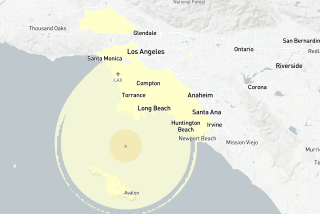California’s tsunami threat
The images of destruction coming from Japan have caused those who dwell on America’s West Coast to wonder: Could a devastating tsunami hit here? The answer is a resounding yes. Our coast is under threat from two types of tsunamis.
One type is caused by earthquakes that happen far away. In the last half-century, the West Coast has experienced tsunamis originating in Chile, Alaska and the Kuril Islands in Russia, as well as last week’s ocean surge from Japan. These tsunamis generated far away will continue to strike the West Coast, given the multiple sources for earthquakes around the Pacific Rim. But they allow for more warning. In Japan, where the earthquake struck, the tsunami followed quickly. But the surge of ocean water took several hours to arrive here, giving people enough time to move out of harm’s way.
A more dangerous though less common tsunami threat on the West Coast is one that arrives within minutes of being generated. In Southern California, there is geologic evidence of rare tsunamis created by earthquake-triggered undersea landslides. Communities to the north are threatened by the Cascadia subduction zone, an offshore seismic region that stretches from Northern California’s Cape Mendocino to southern British Columbia. A Cascadia earthquake and tsunami might well cause the kind of destruction in the Pacific Northwest that we’ve witnessed in Japan this week. The Cascadia subduction zone is capable of generating a magnitude 9.0 earthquake and a “local” tsunami that would begin to inundate coastal communities in a matter of minutes.
Cascadia tsunami-hazard zones in the Pacific Northwest are home to tens of thousands of residents and are visited by hundreds of thousands of tourists. Those who live in the area are taught to evacuate after recognizing natural cues of a tsunami (significant ground shaking from an earthquake, followed by a quick retreat of the ocean from the shoreline) and not to wait for official tsunami warnings.
We cannot predict when the next Cascadia earthquake will occur. But it has been 311 years since the last event, and the time periods between past events have been as short as a couple of centuries. We are within the window for a catastrophe similar to Japan, and that scenario would be the reverse of last week’s events — our coastline would bear the brunt of the devastation, while hours later Japan would see heightened currents in its ports and harbors.
The National Research Council recently reviewed the nation’s tsunami warning system and preparedness efforts and found that much progress has been made. Two warning centers are using seismic data to identify tsunami-triggering earthquakes, and sea-level sensors have been put in place to monitor tsunamis as they cross the ocean. Hazard and evacuation maps have been completed or are underway in most areas. Signs inform people when they are in tsunami-prone areas. Communities are being educated on how to prepare for and respond to distant and local tsunamis. Vulnerability assessments are identifying tourist sites and how many people live or work in hazard zones, and how much time they would need to reach high ground. Some communities are discussing vertical-evacuation options, including engineered berms and buildings.
But despite these advances, there is more to be done to prepare for future tsunamis. The nation needs a comprehensive assessment of tsunami risk to help prioritize funding for warning and education efforts. We also need better methods to increase community resilience to tsunamis.
For distant tsunamis, the Research Council’s report recommends efforts to improve the long-term reliability of sea-level sensors and warning-center operations and to determine whether local officials and the public understand warning messages. Despite vigorous education efforts over recent years, a man died last week in Crescent City, Calif., while attempting to take pictures of the incoming waves. Obviously, more needs to be done to educate the public to stay away from the coast until an “all-clear” message is sent.
For tsunamis generated locally, the Research Council report recommends greater attention be given to educating residents, employees and tourists about how to recognize natural cues and evacuate without official warnings. And we need to make sure people know where to go when the time comes to evacuate. Tsunami education must be a national endeavor because a high percentage of people in tsunami-prone areas at any given time are tourists who have little exposure to local efforts. Tsunami preparedness must become part of the mind-set of everyone who lives, works and plays on the coast.
Great strides have been made in the technological and natural science aspects of tsunamis; however, there is still much to be learned from the social sciences about how to motivate people to change their behavior and to prepare for rare but inevitable tsunamis. An effective warning system is not solely technological; it includes efforts of agencies at multiple levels to improve our understanding of tsunami risk, educate officials and the public on what can be done now to prepare, and train individuals to educate others in their communities about tsunami safety.
The recent tsunami was a good test of our warning system and readiness for future events on the West Coast. But it only tested our readiness for this kind of distant tsunami. Now we need to focus on how we would fare if a magnitude 9.0 earthquake occurred off our coast, and the destructive waves arrived minutes later.
Nathan Wood is a research geographer with the U.S. Geological Survey, an agency of the U.S. Department of the Interior. He was a member of a recent National Research Council committee to review the nation’s tsunami preparedness.
More to Read
A cure for the common opinion
Get thought-provoking perspectives with our weekly newsletter.
You may occasionally receive promotional content from the Los Angeles Times.






